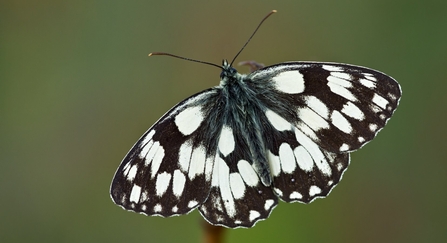Maria Sibylla Merian was famous for her detailed paintings of butterflies and flowers. Yet it is only recently that her contribution to natural science has been fully recognised. At a time when many still believed the caterpillar was a result of spontaneous generation, she drew their full life cycles and challenged gender norms in her scientific study of the natural world. However, her belief in the interconnectedness of art and nature is perhaps more relevant to us now than even she supposed. The decline in insect populations – with butterflies and moths one of the worst effected – signals catastrophic loss, converting their historic use as metaphors for death to something far more literal.
In European art and literature, butterflies have long been symbols tinged with poignancy and loss as well as signs of transformation. In Bosch’s ‘Garden of Earthly Delights’ (1500), Memling’s ‘The Last Judgment’ (1467- 1471), and Bruegel’s ‘The Fall of the Rebel Angels’ (1562) they are the wings of devils and fallen angels in hellish landscapes.

Marbled White credit Guy Edwardes/2020VISION
Renaissance Vanitas paintings often included butterflies as imagery of mortality, whereas the Victorian audiences would have been familiar with their use as symbols of ephemeral childhood and infant death. In Charles Dickens’s ‘Bleak House’, the irony of Mr Skimpole justifying his insistence of perpetual childhood by declaring “I only wish to be free. The butterflies are free” would not be lost.
The fleeting flight of butterflies and their metamorphosis has lent them well to symbolic use in art. Yet, within natural science, their decline signals wider ecological issues. Butterflies’ life cycles mean that they are quickly affected by habitat and climatic change. This, along with the regular records available, means they are used as environmental indicators that demonstrate broader biodiversity and ecosystem trends. Rather than the godly resurrection and rebirth that many historical depictions of butterflies convey to their audiences, this signals a need for far more widespread change.

Young people on the Keeping it Wild programme credit Penny Dixie
About Keeping it Wild
This is a new project, funded by National Lottery Heritage Fund, that will empower and inspire 600 young people aged 11-25, from backgrounds currently under-represented in natural heritage, to gain vital skills while discovering, conserving and sharing their experiences of the capital’s wild spaces. 16-25-year-olds are invited to apply for a 12 week Traineeship, paid via a bursary. They based at one of our reserves, where they spend time learning from the London Wildlife Trust team, gaining valuable practical skills in urban nature conservation. Additional support for the Traineeships has been generously donated by the Worshipful Company of Tallow Chandlers.

Comma butterfly credit Nick Upton/2020VISION
Help butterflies at home
View our wildlife gardening guide for hints and tips on creating a haven for wildlife.
